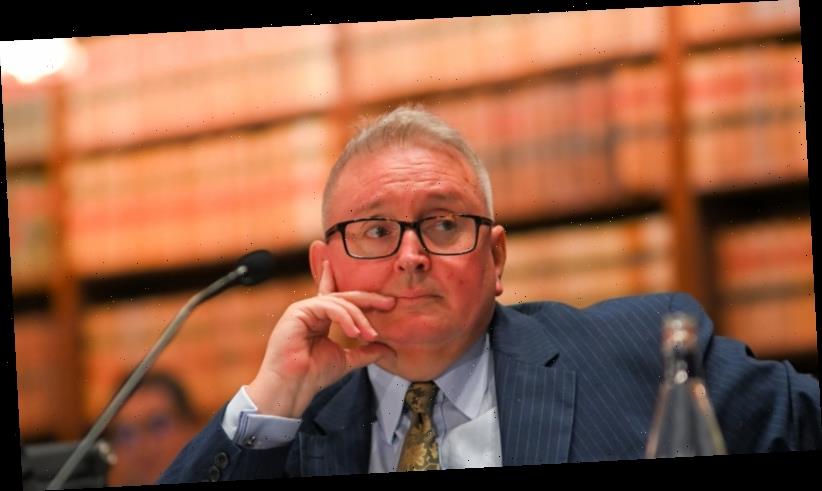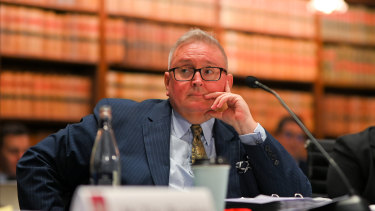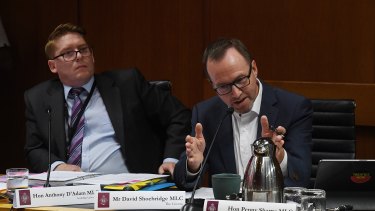Facebook has banned the sharing or viewing of our news articles on its platform. For independent journalism straight from the source, download our app and sign up to our newsletters.
The NSW government has approved more than 400 applications to harm or interfere with Aboriginal heritage sites over the past five years, including 84 applications since last year.
Aboriginal Affairs Minister Don Harwin told the hearing that every Aboriginal Heritage Impact Permit had been ratified in the past 12 months, adding that conditions were attached to the approvals to mitigate impacts.
Aboriginal Affairs Minister Don Harwin at Budget Estimates on Thursday.Credit:Steven Saphore
The NSW government was unable to identify any knock backs to permits submitted over the past five years.
Pressing Mr Harwin over the issue, Greens MP David Shoebridge said NSW was overseeing a scheme of managed destruction rather than managed protection. He said the damage to Aboriginal heritage sites was replicating what had occurred when Rio Tinto blew up 46,000-year-old Aboriginal rock shelters at Juukan Gorge in Western Australia.
Greens MP David Shoebridge: “Are you aware of the fact not a single AHIP has been refused in the past five years?”
Mr Harwin: “I have seen media reports to that affect.”
Upper house Greens MP David Shoebridge.Credit:Kate Geraghty
Mr Shoebridge asked Mr Harwin to account for the 2015 approval by Bathurst Regional Council for a go-kart track on a sacred Aboriginal site at Mount Panorama, despite vocal opposition from local Wiradjuri people.
“The idea that a go-kart track could get anywhere near approval when there are very deep and real concerns… the idea it could even get to first base shows how woefully inadequate our laws are and how you need to exercise your power as a minister,” he said.
Mr Harwin said his department had undertaken consultation with indigenous leaders and council, which raised conflicting views over the physical presence of sites and objects of heritage value.
Council general manager David Sherley on Thursday told The Sydney Morning Herald a cultural heritage assessment had been conducted by qualified consultants.
It found the site did not require the approval of an Aboriginal Heritage Impact Permit and that development “could proceed with caution,” he said. A second stage of construction for the go-kart track will begin March 8.
Mr Harwin also was forced to defend the failure to amend Aboriginal heritage protection laws that class heritage sites under the same legislation as nature and wildlife.
He said the legislative position was “wholly unsatisfactory,” and that overhauling it was an urgent matter this year.
“I’m trying to put things in place to get a result, so at the very least we have a piece of draft legislation,” he said.
Mr Harwin told the estimates hearing he was committed to enacting Aboriginal heritage reform this year, with urgent plans to commission a white paper and committee on the issue.
He conceded that he had made the same commitment in Budget Estimates last year, but said it had not been possible due to the pandemic and his temporary resignation for breaching COVID-19 orders.
Mr Shoebridge said it was galling that in 2021 Aboriginal heritage protection laws were still contained in the National Parks and Wildlife Act.
“That’s where we protect flora and fauna, not First Nations’ cultural heritage,” he said.
Former chair of the NSW Aboriginal Land Council Roy Ah-See said the government had dragged its feet long enough, while there were more than 38,000 outstanding Aboriginal land claims.
“Juukan Gorge should have been enough for governments at all levels to say, we have to protect Aboriginal heritage. NSW is the only state in the country that doesn’t have cultural heritage legislation,” he said.
Start your day informed
Our Morning Edition newsletter is a curated guide to the most important and interesting stories, analysis and insights. Sign up here.
Most Viewed in National
Source: Read Full Article







